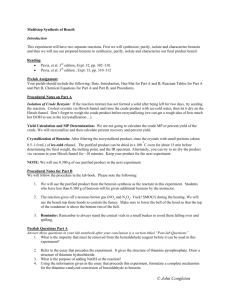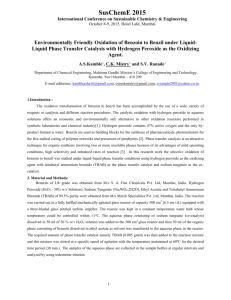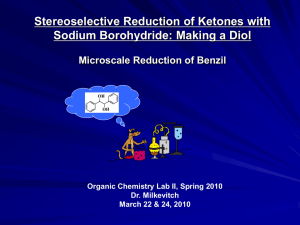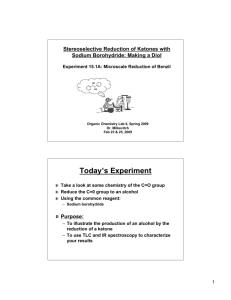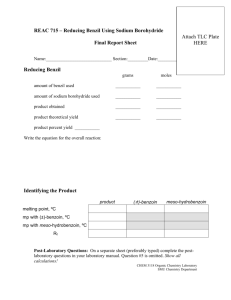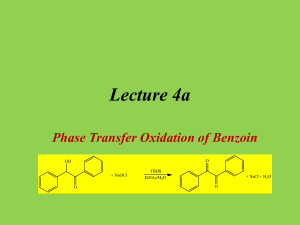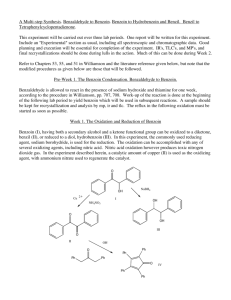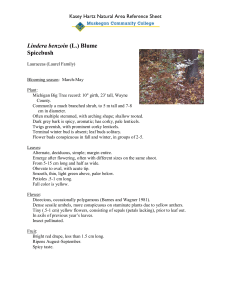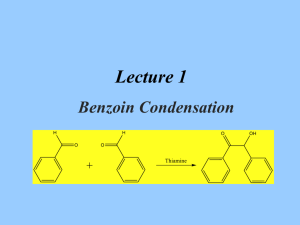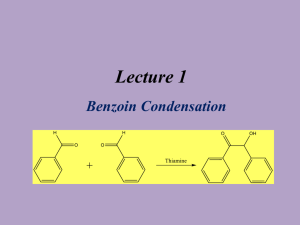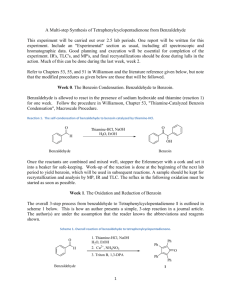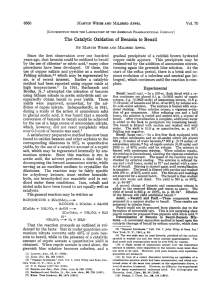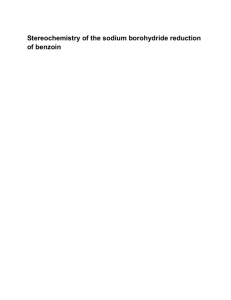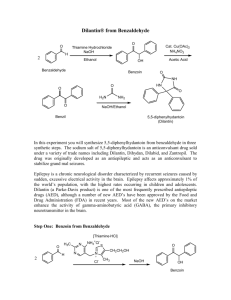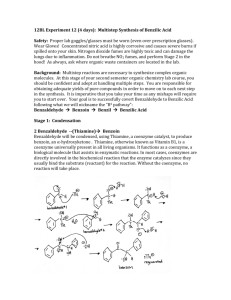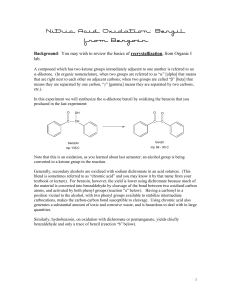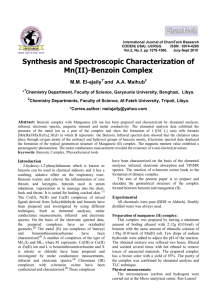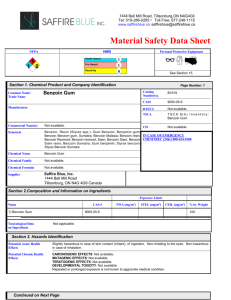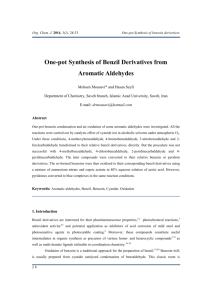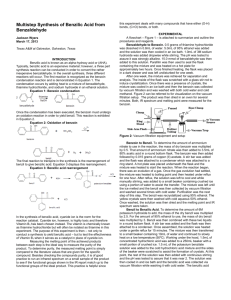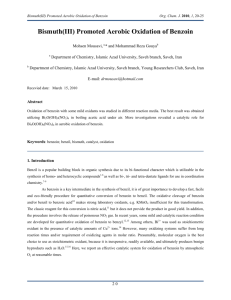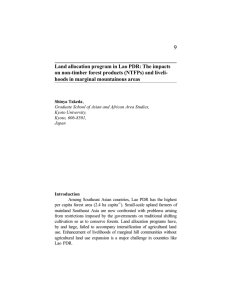Oxidation of benzoin into benzil (n°39)
advertisement
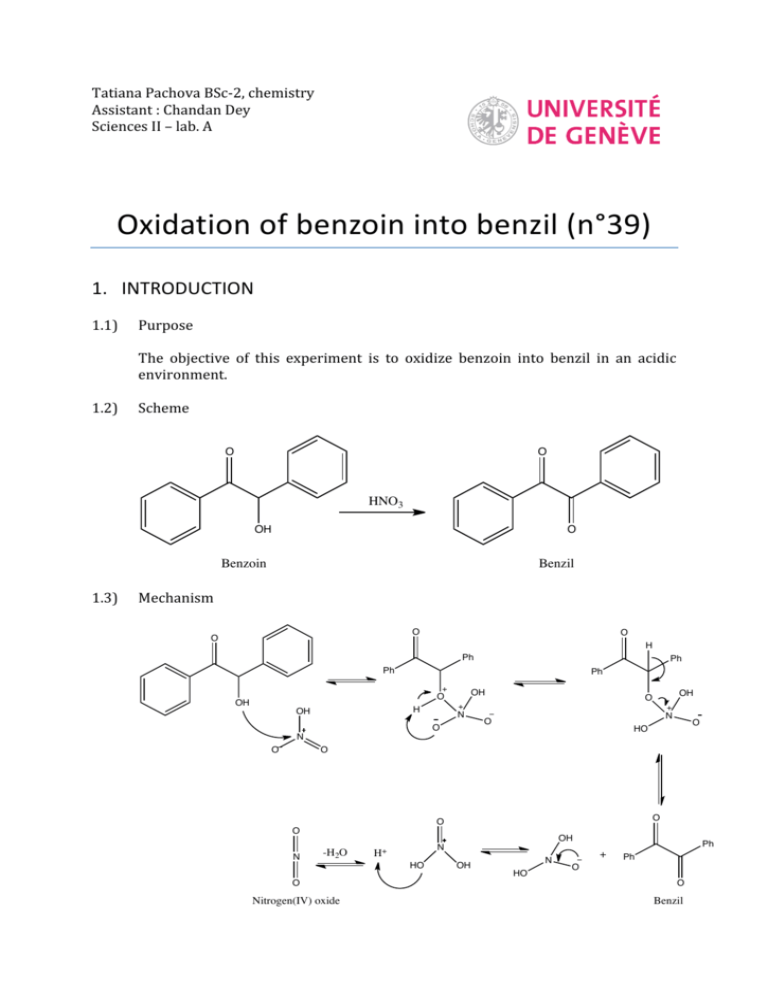
Tatiana Pachova BSc‐2, chemistry Assistant : Chandan Dey Sciences II – lab. A Oxidation of benzoin into benzil (n°39) 1. INTRODUCTION 1.1) 1.2) Purpose The objective of this experiment is to oxidize benzoin into benzil in an acidic environment. Scheme O O HNO3 OH O Benzoin 1.3) Benzil Mechanism O O O H Ph Ph Ph Ph OH O OH H OH N O N O O HO N O OH O O O O O N OH -H2O N H+ HO O Nitrogen(IV) oxide OH N HO Ph + Ph O O Benzil 2. PROCEDURE 2.1) Reaction Reagents molar mass [g/mol] wt/vol taken n [mmol] benzoin acetic acid nitric acid 2.2) 212.24 60.05 63.01 6.0g 30mL 45mL 28.3 excess excess In a 250mL triple‐neck round bottom flask equipped with a refrigerator, 45mL of nitric acid, 30mL of acetic acid and 6g of benzoin were added. The solution was heated at 100°C and agitated until the red fumes were gone. The reaction was followed by the means of TLC (CH2Cl2 was the eluent). Then, the solution was transferred in a flask containing 150mL of cold water and agitated until the precipitate was formed. Isolation The solid product (yellow crystals) were filtered and washed with cold water and then recrystallized in ethanol. 3. DISCUSSION AND RESULTS 3.1) 3.2) Observations There was a strong release of NO2, identified by its red/dark orange fumes. Although the protocol said that the reaction should be finished after about an hour, almost two hours were necessary to its full completion (until the spot corresponding to the reagent disappeared from the TLC plate). The obtained product has a bright yellow color. Yield molar mass [g/mol] n th [mmol] n exp [mmol] yield [%] 210.23 3.3) 28.3 17.5 62% The obtained mass of the product was 3.6833g representing a yield of 62%, which is satisfactory, since the yield given by the protocol was 76% (4.5g). A possible loss might have occurred when washing the crystals with water before recrystallization. Additional analysis • TLC plate, eluent: CH2Cl2: Rf=0.77 (3.9/5.1 and 4/5.2) • Melting point: mp=94.2‐95.5 °C 4. SPECTROMETRY DATA 4.1) NMR 1H (CDCl3, 400MHz) H2 H1 O H3 H1 H2 H2 H1 H3 H1 O H2 The molecule is symmetrical; therefore the shifts are identical for the two “sides”. bond shift ∂ [ppm] multiplicity hydrogen C‐H C‐H C‐H 7.999‐7.980 7.696‐7.658 7.549‐7.511 doublet triplet triplet H1 H3 H2 The substituted groups ketone influence the most hydrogens in position ortho, then para and less of all, meta hydrogens. The coupling constant is exactly the same for all the hydrogens. δ 7.99 (d, J=7.6 Hz, 4H); δ 7.68 (t, J=7.6, 2H); δ 7.53 (t, J=7.6, 4H) 4.2) IR (neat, cm‐1) 1657; 1592‐1578; 1209; 1173; 874; 716; 694‐680; 639 Indeed there is a peak corresponding to the stretch of the ketone group C=O, but no peaks for the O‐H that were in the benzoin. So the product is indeed benzyl. 5. REFERENCES [1] Travaux Pratiques de Chimie Organique 3ème Semestre, 21 Novembre 2011 – 16 Mars 2012, 39 [2] Silverstein, Bassler, Morrill, Spectrometric identification of organic compounds [3] Vollhart‐Schore, Traité de chimie organique, 5ème edition, 2009, p.303 6. QUESTIONS 1) What characteristic frequencies should you search in an IR spectrum of benzoin and benzyl? In the benzoin spectrum, you expect to see a peak at 3400‐3300 cm‐1 corresponding to the O‐H stretch and in the benzyl spectrum, you should see a peak at 1715 cm‐1 corresponding to the C=O stretch. 2) What is the mechanism of the oxidation of a secondary alcohol by chromium trioxide? O R2 R1 OH H HO Cr R2 OH -H2O R2 R1 O H O O O Cr O OH H2O 7. ANNEXES IR spectrum, NMR spectrum + H3O+ + O3CrH- R1
